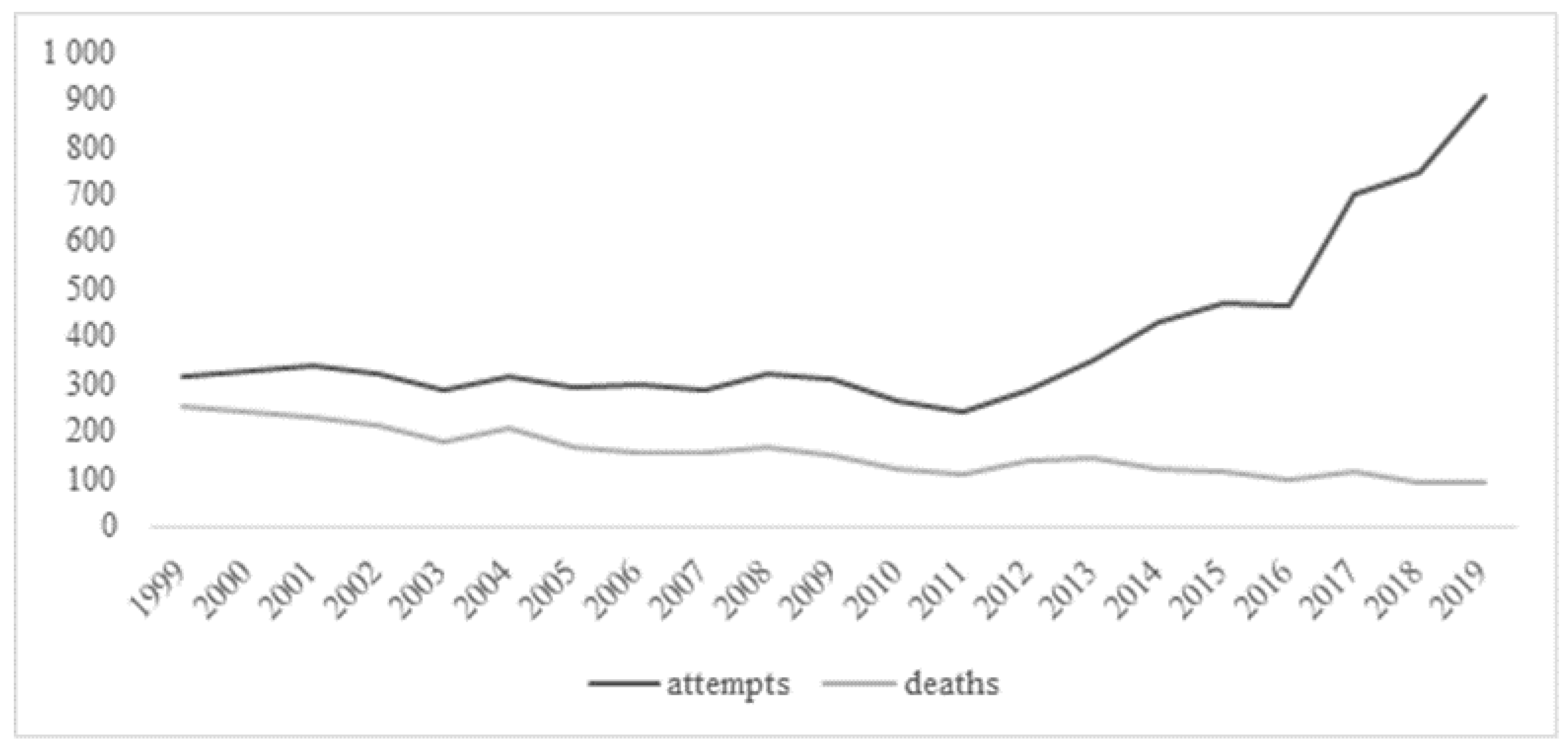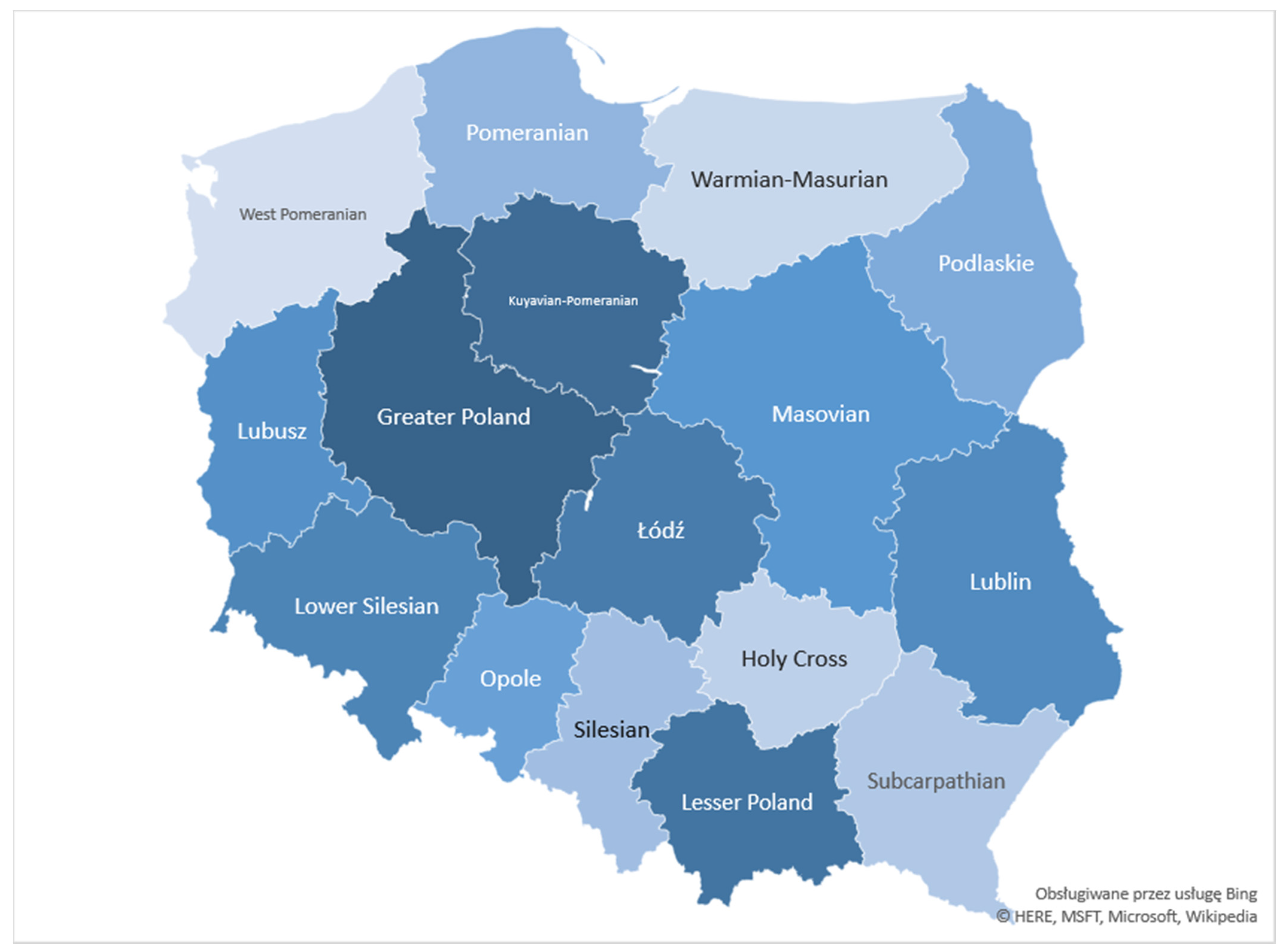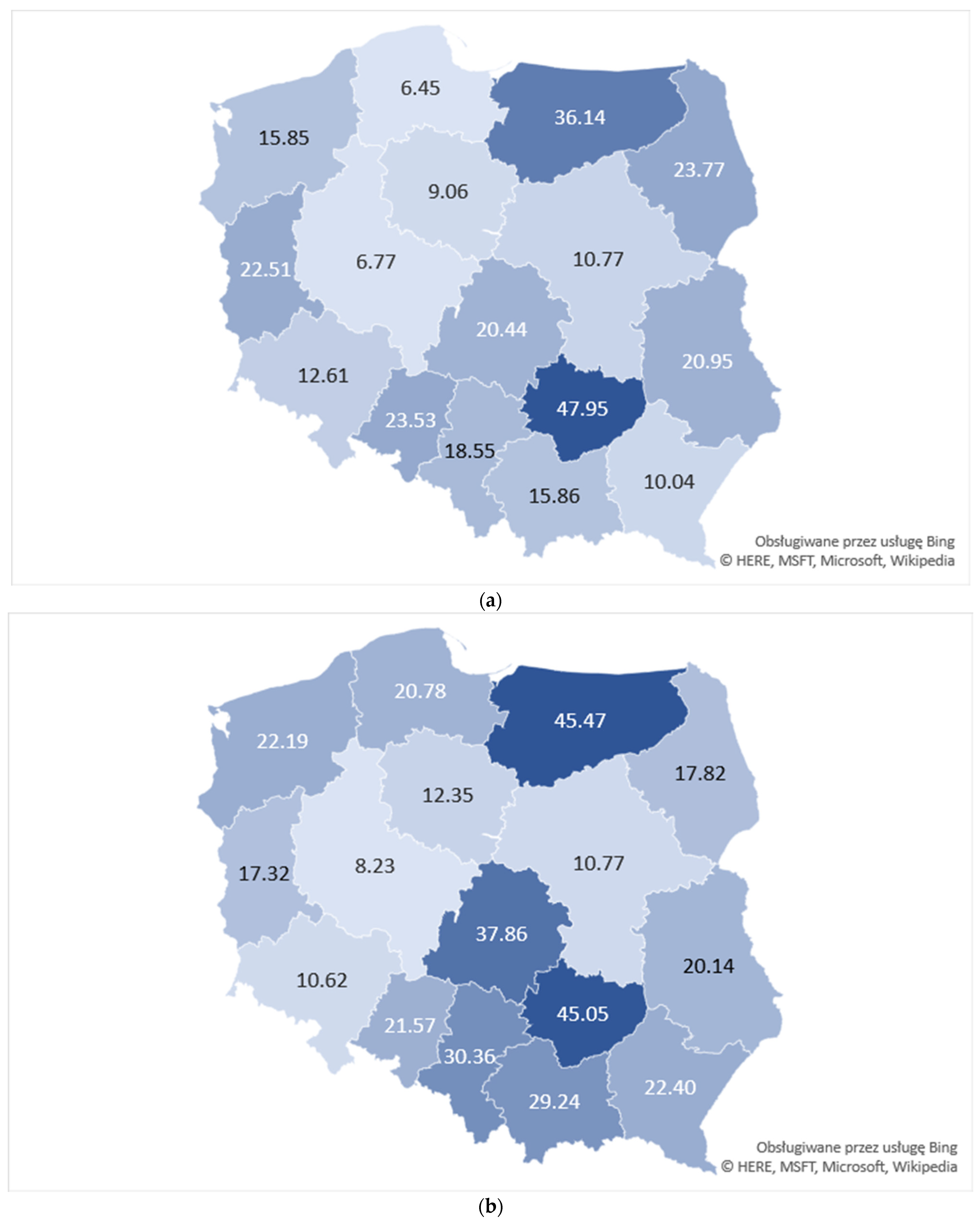Suicide among Polish Adolescents—A 20 Year Analysis
Abstract
1. Introduction
2. Materials and Methods
3. Results
3.1. Costs of Premature Mortality
3.2. Territorial Diversity
3.3. Correlation Analysis
4. Discussion
5. Conclusions
Supplementary Materials
Author Contributions
Funding
Institutional Review Board Statement
Informed Consent Statement
Data Availability Statement
Conflicts of Interest
References
- Shain, B. Suicide and suicide attempts in adolescents. Pediatrics 2016, 1, 138. [Google Scholar] [CrossRef]
- Cerel, J.; Brown, M.; Maple, M.; Singleton, M.; van de Venne, J.; Moore, M.; Van de Venne, J.; Moore, M.; Flaherty, C. How Many People Are Exposed to Suicide? Not Six. Suicide Life-Threat. Behav. 2018, 49, 529–534. [Google Scholar] [CrossRef] [PubMed]
- Picazo-Zappino, P.Z. Suicide among children and adolescents: A review. Actas Esp. Psiquiatr. 2014, 42, 125–132. [Google Scholar]
- Kułaga, Z. Aktualne trendy zewnętrznych przyczyn zgonów dzieci i młodzieży w Polsce. Probl. Hig. Epidemiol. 2009, 90, 332–341. [Google Scholar]
- Grajda, A.; Kułaga, Z.; Gurzkowska, B.; Góźdź, M.; Wojtyło, M.; Litwin, M. Trends in external causes of child and adolescent mortality in Poland, 1999–2012. Int. J. Public Health 2017, 62, 117–126. [Google Scholar] [CrossRef] [PubMed]
- Miranda-Mendizabal, A.; Castellví, P.; Parés-Badell, O.; Alayo, I.; Almenara, J.; Alonso, I.; Almenara, J.; Alonso, I.; Blasco, M.J.; Cebria, A. Gender differences in suicidal behavior in adolescents and young adults: Systematic review and meta-analysis of longitudinal studies. Int. J. Public Health 2019, 64, 265–283. [Google Scholar] [CrossRef]
- Mroczkowska-Juchkiewicz, A.; Krawiec, P.; Pawłowska-Kamieniak, A.; Gołyska, D.; Kominek, K.; Pac-Kożuchowska, E. Intentional spoisonings in urban and rural children—A 6-year retrospective single centre study. Ann Agric. Environ. Med. 2016, 23, 482–486. [Google Scholar] [CrossRef]
- Makara-Studzinska, M.; Sygit, K.; Sygit, M.; Gozdziewska, M.; Zubilewicz, J.; Krys-Noszczyk, K. Analysis of the phenomenon of attempted suicides in 1978–2010 in Poland, with particular emphasis on rural areas of lublin province. Ann. Agric. Environ. Med. 2012, 19, 762–769. [Google Scholar]
- Gmitrowicz, A.; Wolanek, U.; Madej, A.; Studzińska, M.-M. Motywy podejmowania prób samobójczych przez młodzież w wieku 13–19 lat. J. Educ. Heal Sport. 2015, 5, 51–64. [Google Scholar]
- Campisi, S.C.; Carducci, B.; Akseer, N.; Zasowski, C.; Szatmari, P.; Bhutta, Z.A. Suicidal behaviours among adolescents from 90 countries: A pooled analysis of the global school-based student health survey. BMC Public Health 2020, 20, 1102. [Google Scholar] [CrossRef]
- Zygo, M.; Pawłowska, B.; Potembska, E.; Dreher, P.; Kapka-Skrzypczak, L. Prevalence and selected risk factors of suicidal ideation, suicidal tendenciesand suicide attempts in young people aged 13–19 years. Ann. Agric. Environ. Med. 2019, 26, 329–336. [Google Scholar] [CrossRef]
- General Police Headquarters. Suicide and Suicide Attempts Rates in Poland. Available online: http://statystyka.policja.pl/ (accessed on 18 February 2020).
- Statistics Poland. Polish Population Tables. Available online: https://stat.gov.pl/ (accessed on 18 February 2020).
- World Health Organization. WHO Methods and Data Sources for Global Burdes and Information Systems WHOn of dIsease Estimates 2000–2011. Glob Heal Estim Tech Pap WHO/HIS/HSI/GHE/20134. Available online: http://www.who.int/healthinfo/statistics/GlobalDALYmethods_2000_2011.pdf?ua=1 (accessed on 18 November 2013).
- Wang, H.; Naghavi, M.; Allen, C.; Barber, R.M.; Carter, A.; Casey, D.C.; Charlson, F.J.; Chen, A.Z.; Coates, M.M.; Coggeshall, M.; et al. Global, regional, and national life expectancy, all-cause mortality, and cause-specific mortality for 249 causes of death, 1980–2015: A systematic analysis for the Global Burden of Disease Study 2015. Lancet 2016, 388, 1459–1544. [Google Scholar] [CrossRef]
- Zhou, M.; Wang, H.; Zeng, X.; Yin, P.; Zhu, J.; Chen, W.; Li, X.; Wang, L.; Wang, L.; Liu, Y.; et al. Global, regional, and national age-sex specific all-cause and cause-specific mortality for 240 causes of death, 1990–2013: A systematic analysis for the Global Burden of Disease Study 2013. Lancet 2015, 385, 117–171. [Google Scholar] [CrossRef]
- Pike, J.; Grosse, S.D. Friction Cost Estimates of Productivity Costs in Cost-of-Illness Studies in Comparison with Human Capital Estimates: A Review. Appl. Health Econ. Health Policy 2018, 16, 765–778. [Google Scholar] [CrossRef]
- Social Insurance Institution (ZUS). Average Salary for Years 1950–2019. Available online: https://www.zus.pl/baza-wiedzy/skladki-wskazniki-odsetki/wskazniki/przecietne-wynagrodzenie-w-latach (accessed on 30 March 2020).
- Statistics Poland. Women and Men on the Labour Market 2004; Statistics Poland: Poznań, Poland, 2004.
- Statistics Poland. Women and Men on the Labour Market 2014; Statistics Poland: Poznań, Poland, 2014.
- Statistics Poland. Women and Men on the Labour Market 2018; Statistics Poland: Poznań, Poland, 2018.
- Agency for Health Technology Assessment and Tariff System. HTA Guidelines; Agency for Health Technology Assessment and Tariff System: Warsaw, Poland, 2016. [Google Scholar]
- Historic Inflation Poland (CPI). Available online: https://www.inflation.eu/en/inflation-rates/poland/historic-inflation/cpi-inflation-poland.aspx (accessed on 2 March 2021).
- Bieńkuńska, A.; Ciecieląg, P.; Haponiuk, M.; Nałęcz, S.; Sobestjański, K.; Wieczorkowski, R.; Jachowicz, I.; Kolasa, E.; Piasecki, T.; Szkopiecka, K.; et al. Regional Diversity of Quality of Life in 2015. 2017. Available online: https://stat.gov.pl/obszary-tematyczne/warunki-zycia/dochody-wydatki-i-warunki-zycia-ludnosci/terytorialne-zroznicowanie-jakosci-zycia-w-polsce-w-2015-r-,25,1.html (accessed on 3 March 2021).
- Verger, D.; Lebrere, A.; Bienkunska, A.; Ciecieląg, P.; Nałęcz, S.; Piaskowski, P.; Wieczorkowski, R.; Lednicki, B. Quality of life. Social capital, poverty and social exclusion in Poland. 2014. Available online: http://stat.gov.pl/en/topics/living-conditions/living-conditions/quality-of-life-social-capital-poverty-and-social-exclusion-in-poland,4,1.html (accessed on 3 March 2021).
- McLoughlin, A.B.; Gould, M.S.; Malone, K.M. Global trends in teenage suicide: 2003–2014, QJM. Int. J. Med. 2015, 108, 765–780. [Google Scholar] [CrossRef] [PubMed]
- CO4.4: Teenage Suicides (15–19 Years Old). OECD Family Database. Available online: http://www.oecd.org/els/family/database.html (accessed on 4 March 2021).
- Belsher, B.E.; Smolenski, D.J.; Pruitt, L.D.; Bush, N.E.; Beech, E.H.; Workman, D.E.; Morgan, R.L.; Evatt, D.P.; Tucker, J.; Skopp, N.A. Prediction Models for Suicide Attempts and Deaths: A Systematic Review and Simulation. JAMA Psychiatry 2019, 76, 642–651. [Google Scholar] [CrossRef] [PubMed]
- Social Affairs. CO4. 1: Teenage Suicide (15–19 years old) Definitions and methodology Key Findings. 2009. Available online: www.oecd.org/els/family/database.html (accessed on 18 February 2020).
- Kann, L.; McManus, T.; Haris, W.A. Youth risk behavior surveillance United States, 2017. MMWR Surveill. Summ. 2018, 68, 24–28. [Google Scholar] [CrossRef] [PubMed]
- Lindsey, M.A.; Sheftall, A.H.; Xiao, Y.; Joe, S. Trends of suicidal behaviors among high school students in the United States: 1991–2017. Pediatrics 2019, 144. [Google Scholar] [CrossRef] [PubMed]
- Van Vuuren, C.L.; van der Wal, M.F.; Cuijpers, P.; Chinapaw, M.J.M. Sociodemographic Differences in Time Trends of Suicidal Thoughts and Suicide Attempts Among Adolescents Living in Amsterdam, The Netherlands. Crisis 2020, 1–9. [Google Scholar] [CrossRef] [PubMed]
- Soares, F.C.; Hardman, C.M.; Rangel Junior, J.F.B.; Bezerra, J.; Petribú, K.; Mota, J.; de Barros, M.V.G.; Lima, R.A. Secular trends in suicidal ideation and associated factors among adolescents. Braz. J. Psychiatry. 2020, 42, 475–480. [Google Scholar] [CrossRef]
- Bachmann, S. Epidemiology of Suicide and the Psychiatric Perspective. Int. J. Environ. Res. Public Health 2018, 15, 1425. [Google Scholar] [CrossRef] [PubMed]
- Stradomska, M.; Wolińska, J.; Marczak, M. Uwarunkowania prób samobójczych u nastoletnich pacjentów szpitali i klinik psychiatrycznych w perspektywie psychologicznej. Psychiatr Psychol. Klin. 2016, 16, 136–149. [Google Scholar] [CrossRef]
- Bąbik Aleksandra, O.D. Uwarunkowania i profilaktyka samobójstw wśród dzieci i młodzieży w Polsce. Dziecko KrzywdzoneTeoria Bad. Prakt. 2014, 13, 99–121. [Google Scholar]
- Mazur, J.; Małkowska-Szkutnik, A. Zdrowie Uczniów w 2018 Roku Na Tle Nowego Modelu Badań HBSC. Warsaw. 2018, pp. 13–16. Available online: https://www.researchgate.net/publication/332071980_ZDROWIE_UCZNIOW_W_2018_ROKU_NA_TLE_NOWEGO_MODELU_BADAN_HBSC (accessed on 18 February 2020).
- Pyżalski, J. Agresja Elektroniczna i Cyberbullying Jako Nowe Ryzykowne Zachowania Młodzieży. 2012. Available online: http://repozytorium.amu.edu.pl/handle/10593/5939 (accessed on 18 February 2020).
- Kropiwnicki, P.; Gmitrowicz, A. Światowe Inicjatywy W Zakresie Profilaktyki Samobójstw. Psychiatr. Psychol. Klin. 2013, 13, 202–206. [Google Scholar]
- Szymańska, J. Zapobieganie Samobójstwom Dzieci i Młodzieży, 4th ed.; Ośrodek Rozwoju Edukacji: Warsaw, Poland, 2016. [Google Scholar]
- Farrell, C.T.; Moledina, Z.; Katta, M. Suicidal thoughts in low-income adolescents: A longitudinal analysis. Int. J. Public Health 2019, 64, 285–292. [Google Scholar] [CrossRef] [PubMed]
- Koszewska, I.; Średniawa, M.; Koszewska, J. Internet i Nowe Technologie w Zapobieganiu Samob Ójstwom Raport na Zlecenie Maic; Researchgate: Berlin, Germany, 2014. [Google Scholar]
- Gmitrowicz, A.; Baran, A.; Ostaszewski, K. The Milestones of Development of National Suicide Preventive Strategy in Poland; 27th European Congress of Psychiatry: Warsaw, Poland, 2019. [Google Scholar]
- Maślankiewicz, R.; Bójko, M. Psychiatria Dzieci i Młodzieży w Polsce; Sieć Obywatelska Watchdog Polska; Watchdog Poland: Warsaw, Poland, 2019. [Google Scholar]
- Polish Press Agency. Interview with the Deputy Minister of Health. 2020. Available online: http://nauka.pap.pl/palio/html.run?_Instance=cms_nauka.pap.pl&_PageID=7&dep=338020&_CheckSum=1843758126 (accessed on 10 April 2020).
- National Health Fund. Decree Nr 17/2020/DEF. 2020. Available online: https://www.nfz.gov.pl/zarzadzenia-prezesa/zarzadzenia-prezesa-nfz/zarzadzenie-nr-172020def,7125.html (accessed on 20 April 2020).
- World Health Organization. Preventing Suicide; World Health Organization: Geneva, Switzerland, 2014. [Google Scholar]
- Katz, C.; Bolton, J.; Sareen, J. The prevalence rates of suicide are likely underestimated worldwide: Why it matters. Soc. Psychiatry Psychiatr. Epidemiol. 2016, 51, 125–127. [Google Scholar] [CrossRef] [PubMed]
- Auger, N.; Burrows, S.; Gamache, P.; Hamel, D. Suicide in Canada: Impact on injuries of undetermined intent on regional rankings. Inj. Prev. 2016, 22, 76–78. [Google Scholar] [CrossRef] [PubMed]
- Bakst, S.S.; Braun, T.; Zucker, I.; Amitai, Z.; Shohat, T. The accuracy of suicide statistics: Are true suicide deaths misclassified? Soc. Psychiatry Psychiatr. Epidemiol. 2016, 51, 115–123. [Google Scholar] [CrossRef]



| Thematic Area | Indicator | Definition |
|---|---|---|
| Social capital | Association-based social capital | % of persons aged 16 or more who declared their involvement in at least one organisation, association, or formal group |
| Satisfaction with family situation | % of persons aged 16 years or more, declaring that they were satisfied with their current family situation | |
| Poverty | Income poverty | % of households in which the monthly equivalised income at household’s disposal (within 12 months preceding the survey) was lower than the value regarded as the poverty threshold. The poverty threshold was assumed at 60% of the median equivalised income, i.e., income comparable between households with different demographic structures |
| Living conditions poverty | % of households in which at least 10 indications of poor living conditions were observed, based on the list of 30 symptoms concerning the dwelling quality, the provision of durable consumer goods, and the deprivation of various types of consumer needs |
| Attempts /100,000 | Deaths /100,000 | Attempts /death /100,000 | YLL/All Deaths acc. WHO GHE | YLL/All Deaths acc. GBD 2015 | Costs of Lost Productivity/All Deaths (in PLN, 2020) | Cost of Lost Productivity /GDP Per Capita | ||
|---|---|---|---|---|---|---|---|---|
| Base Case Analysis | Sensitivity Analysis | |||||||
| 1999 | 14.6 | 11.6 | 1.3 | 19,337 | 16,797 | 182,286,315.30 | 454,223,172.10 | 5873 |
| 2000 | 15.2 | 11.1 | 1.4 | 18,490 | 16,061 | 176,782,502.60 | 434,316,977.30 | 5624 |
| 2001 | 15.5 | 10.5 | 1.5 | 17,642 | 15,325 | 159,399,636.40 | 414,410,782.50 | 5266 |
| 2002 | 14.7 | 9.8 | 1.5 | 16,332 | 14,187 | 143,655,545.60 | 383,646,663.30 | 4728 |
| 2003 | 13.2 | 8.3 | 1.6 | 13,867 | 12,046 | 124,224,452.10 | 325,737,733.00 | 3946 |
| 2004 | 14.6 | 9.6 | 1.5 | 16,024 | 13,919 | 196,665,099.60 | 376,408,047.00 | 5759 |
| 2005 | 13.5 | 7.7 | 1.8 | 12,866 | 11,176 | 161,616,281.10 | 302,212,230.10 | 4644 |
| 2006 | 13.7 | 7.2 | 1.9 | 12,018 | 10,440 | 160,681,561.00 | 282,306,035.30 | 4311 |
| 2007 | 13.3 | 7 | 1.9 | 11,787 | 10,239 | 181,540,059.20 | 276,877,073.00 | 4446 |
| 2008 | 14.8 | 7.6 | 1.9 | 12,789 | 11,109 | 208,209,092.20 | 300,402,576.00 | 4893 |
| 2009 | 14.4 | 7 | 2.1 | 11,710 | 10,172 | 195,305,946.80 | 275,067,419.00 | 4479 |
| 2010 | 12.3 | 5.5 | 2.2 | 9168 | 7963 | 150,594,102.40 | 215,348,834.60 | 3400 |
| 2011 | 11.2 | 5.1 | 2.2 | 8551 | 7428 | 117,833,706.10 | 200,871,602.00 | 2537 |
| 2012 | 13.2 | 6.4 | 2.1 | 10632 | 9235 | 151,882,950.50 | 249,732,262.00 | 3298 |
| 2013 | 16 | 6.6 | 2.4 | 11094 | 9636 | 163,673,765.90 | 260,590,186.40 | 3583 |
| 2014 | 19.7 | 5.7 | 3.5 | 9553 | 8298 | 145,230,212.10 | 224,397,105.00 | 3080 |
| 2015 | 21.6 | 5.2 | 4.1 | 8783 | 7629 | 145,218,552.30 | 206,300,564.20 | 2898 |
| 2016 | 21.5 | 4.7 | 4.6 | 7781 | 6759 | 134,398,252.20 | 182,775,061.30 | 2573 |
| 2017 | 32.3 | 5.3 | 6.1 | 8860 | 7696 | 186,893,350.60 | 208,110,218.30 | 3381 |
| 2018 | 34.4 | 4.2 | 8.1 | 7088 | 6157 | 15,465,630.40 | 166,488,174.60 | 2681 |
| 2019 | 41.7 | 4.3 | 9.6 | 7242 | 6290 | 170,100,368.60 | 170,107,482.80 | 2765 |
| mean | 18 | 7 | 3 | 11,982 | 10,408 | 153,172,414.54 | 281,444,295.23 | 4208 |
Publisher’s Note: MDPI stays neutral with regard to jurisdictional claims in published maps and institutional affiliations. |
© 2021 by the authors. Licensee MDPI, Basel, Switzerland. This article is an open access article distributed under the terms and conditions of the Creative Commons Attribution (CC BY) license (http://creativecommons.org/licenses/by/4.0/).
Share and Cite
Orlewska, K.; Orlewski, P.; Klusek, J. Suicide among Polish Adolescents—A 20 Year Analysis. Int. J. Environ. Res. Public Health 2021, 18, 3190. https://doi.org/10.3390/ijerph18063190
Orlewska K, Orlewski P, Klusek J. Suicide among Polish Adolescents—A 20 Year Analysis. International Journal of Environmental Research and Public Health. 2021; 18(6):3190. https://doi.org/10.3390/ijerph18063190
Chicago/Turabian StyleOrlewska, Katarzyna, Pawel Orlewski, and Justyna Klusek. 2021. "Suicide among Polish Adolescents—A 20 Year Analysis" International Journal of Environmental Research and Public Health 18, no. 6: 3190. https://doi.org/10.3390/ijerph18063190
APA StyleOrlewska, K., Orlewski, P., & Klusek, J. (2021). Suicide among Polish Adolescents—A 20 Year Analysis. International Journal of Environmental Research and Public Health, 18(6), 3190. https://doi.org/10.3390/ijerph18063190






